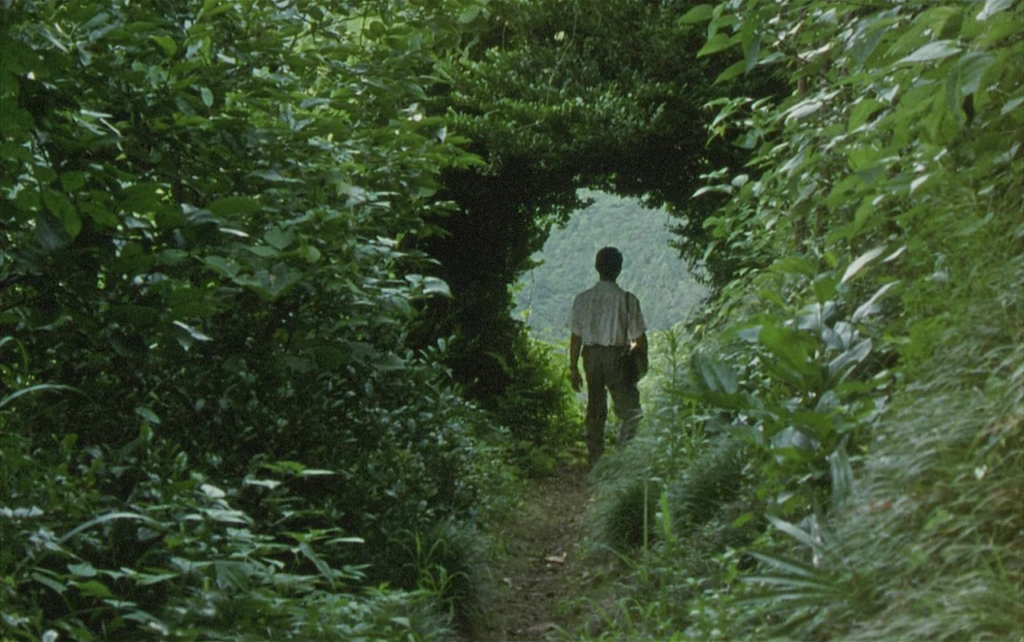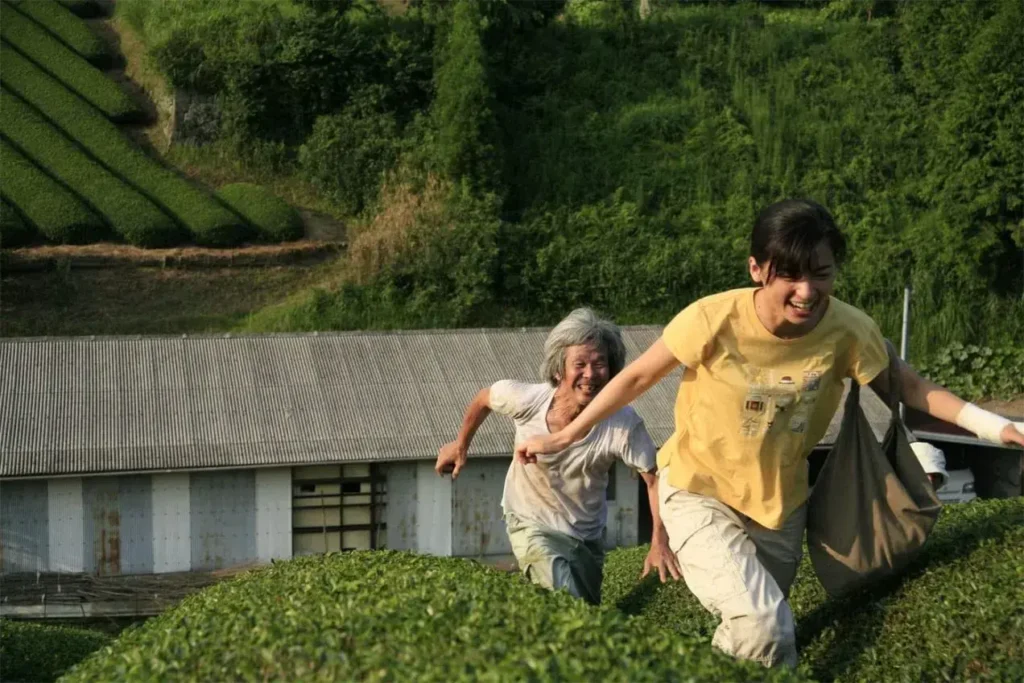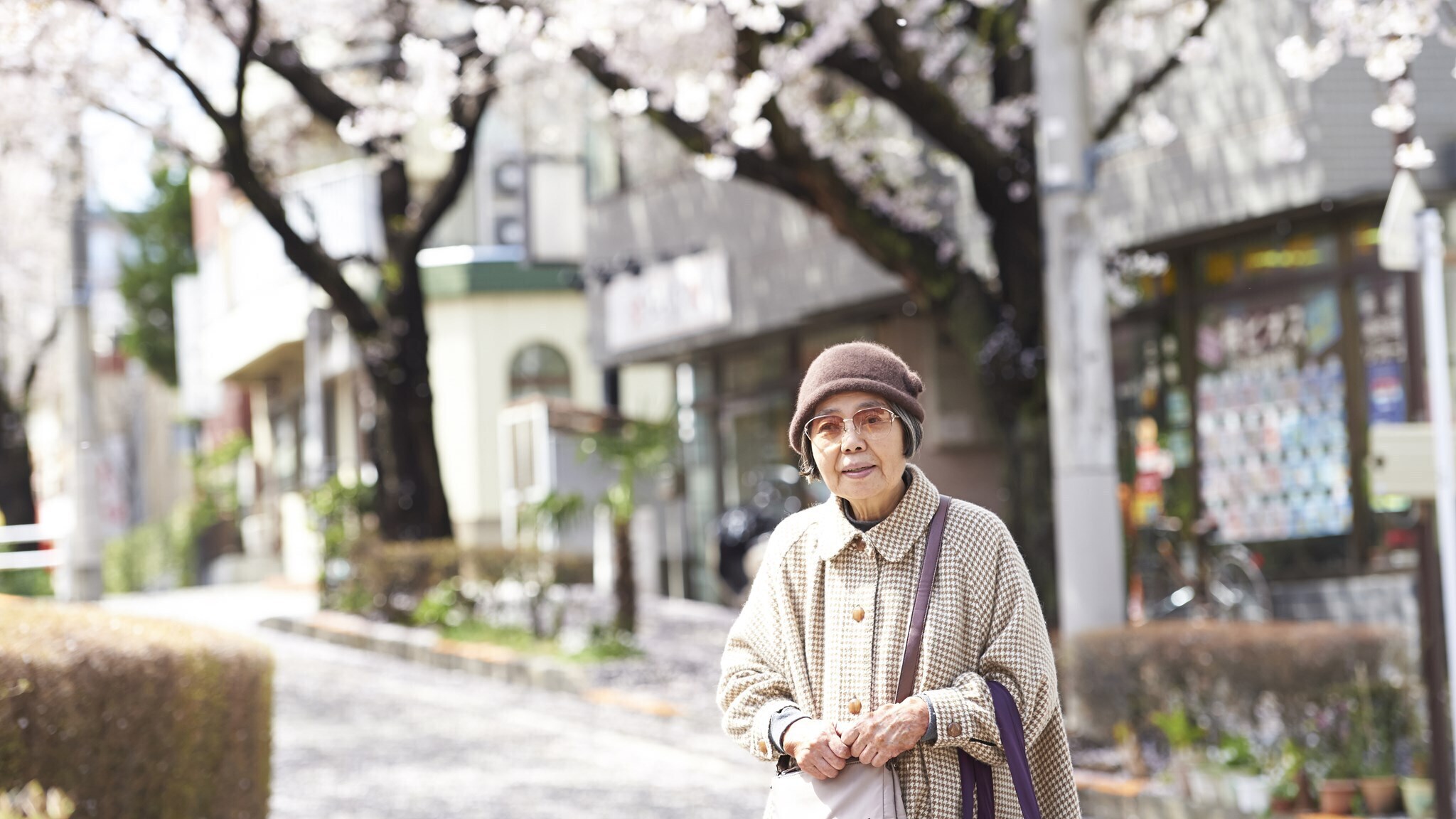The Many Branches of Naomi Kawase’s Cinematic Family Tree

Written by Joshua Bippert, AFS Creative Careers Intern
Naomi Kawase is searching — searching for answers to her own familial histories and to her own identity. The Japanese director searches in grainy personal film diaries or, at times, lyrical narrative features. As part of Austin Film Society’s latest Essential Cinema series, YOU’RE MY GREATEST TREASURE: 10 EXERCISES IN INTIMACY, AFS Cinema will be screening Naomi Kawase’s THE GRANDMOTHER TRILOGY (1994–1996). This trilogy is considered Kawase’s breakthrough and is comprised of 8mm film diaries in which Kawase examines her relationship with her adopted grandmother. The form of these films is one she established before the trilogy but continued to develop even into her later narrative features, and it’s a leading example of the autobiographical eye that Kawase would even extend to the personal, spiritual narrative films of her career. The influence THE GRANDMOTHER TRILOGY had on the rest of her filmography, a body of work that records Naomi Kawase’s own infatuation with interrogating herself and family, is fascinating and well worth exploring.
Naomi Kawase’s journey through her family history began with 1992’s EMBRACING, a short documentary, or film diary, about the process of finding the father she never knew while beginning to peer into her connection to her grandmother. Her relationship with her parents was largely nonexistent, and they split quickly after Kawase’s birth and left her to be adopted and raised by her great aunt (whom she has always referred to as her grandmother). EMBRACING serves as the first signifier of her perspective as a filmmaker: distinctly feminine, inquisitive, and entirely subjective. The film shows how she views the world, whether that’s by showing photographs of her childhood or playing audio of what her father’s voice sounds like over the phone after finally finding him.
 Kawase’s relationship with her parents is further dissected in SKY, WIND, FIRE, WATER, EARTH (2001) where she processes the sudden death of her long-absent father. The film begins with her looking back on her previous film diaries, EMBRACING and THE GRANDMOTHER TRILOGY. The audience is invited to join her as she subjectively approaches the interpretation of her past and begins to understand the impact her upbringing had on her sense of self. In an effort to further define this, we are given access to conversations with her mother about motherhood and the dissolution of her parents’ marriage. Later she visits a tattoo artist, initially contemplating getting an identical tattoo to her father’s, engaging in a lengthy conversation about her creativity, trauma, and even her own narcissism. Kawase, at her core, uses her films, regardless of genre, to answer her own questions about life. Would her career be where it is now without the separation of her parents? Can the death of a loved one shake one’s regard for mortality or even redefine the trajectory of an artist’s output? These self discoveries are significant to understanding Kawase’s cinema.
Kawase’s relationship with her parents is further dissected in SKY, WIND, FIRE, WATER, EARTH (2001) where she processes the sudden death of her long-absent father. The film begins with her looking back on her previous film diaries, EMBRACING and THE GRANDMOTHER TRILOGY. The audience is invited to join her as she subjectively approaches the interpretation of her past and begins to understand the impact her upbringing had on her sense of self. In an effort to further define this, we are given access to conversations with her mother about motherhood and the dissolution of her parents’ marriage. Later she visits a tattoo artist, initially contemplating getting an identical tattoo to her father’s, engaging in a lengthy conversation about her creativity, trauma, and even her own narcissism. Kawase, at her core, uses her films, regardless of genre, to answer her own questions about life. Would her career be where it is now without the separation of her parents? Can the death of a loved one shake one’s regard for mortality or even redefine the trajectory of an artist’s output? These self discoveries are significant to understanding Kawase’s cinema.
Naomi Kawase’s shift towards narrative features seems like an effort to play with her point of view more broadly. Kawase has always considered herself a filmmaker with a documentarian’s sensibilities. Her films are often high concept, ethereal, and poetic but grounded in a sense of real, lived experience. Three of her first four features are set in the Nara prefecture of Japan where Kawase herself resides. In her debut feature, SUZAKU (winner of the 1997 Caméra d’Or at Cannes), a real-life logging village in the midst of economic decline is the setting for a family grappling with their recently lost patriarch. The film establishes Kawase’s continued use of non-professional actors (employing much of the village’s residents) and themes that would continue to be showcased throughout her work: family and mortality, our connection to the natural world, womanhood, and budding sensuality.
 Often in her work, Kawase’s camera feels voyeuristic. Persistently handheld, the camera follows or invades the spaces of her characters. In the opening of SHARA (2003), the camera meanders through a building and happens upon two young brothers playing together before following them (in an impressive long take) as they play tag through a labyrinthine neighborhood. It feels invasive until the scene serves to reveal the inexplicable disappearance of one of the brothers. The film then follows two teenagers as they approach adulthood: one boy, Shun, still working through the guilt and grief of losing his brother years prior as his mother (played by Naomi Kawase herself) is approaching the birth of another child; and a girl, Yu, questioning her own identity when she learns that her mother is actually her aunt (a clear self-referential plot). The film ends with Shun’s mother giving birth, shot in a way that make it feel like we’re intruding on the family in this private moment. Again, here, the camera lingers, revealing the wonder and community that new life can bring.
Often in her work, Kawase’s camera feels voyeuristic. Persistently handheld, the camera follows or invades the spaces of her characters. In the opening of SHARA (2003), the camera meanders through a building and happens upon two young brothers playing together before following them (in an impressive long take) as they play tag through a labyrinthine neighborhood. It feels invasive until the scene serves to reveal the inexplicable disappearance of one of the brothers. The film then follows two teenagers as they approach adulthood: one boy, Shun, still working through the guilt and grief of losing his brother years prior as his mother (played by Naomi Kawase herself) is approaching the birth of another child; and a girl, Yu, questioning her own identity when she learns that her mother is actually her aunt (a clear self-referential plot). The film ends with Shun’s mother giving birth, shot in a way that make it feel like we’re intruding on the family in this private moment. Again, here, the camera lingers, revealing the wonder and community that new life can bring.
 The death of her father and the impending (and eventual) death of her grandmother influenced many of Naomi Kawase’s following films. TARACHIME (2006) saw her point the camera toward herself again as she documented her own pregnancy and childbirth while reckoning with her grandmother’s deteriorating health. THE MOURNING FOREST (winner of the 2007 Grand Prix at Cannes) sees a caretaker and elderly man, both grieving, lose themselves in a local forest, in a tale about the use of work as a distraction from processing one’s emotions. And again in STILL THE WATER (2014), the ephemeral nature of life is displayed as a teenage couple learns to let go of those who leave. It may seem obvious to some for an auteur to mine their own life for art, but Naomi Kawase embraces this technique — she breathes her experiences into broader characters for us to relate to, sure, but also for her own well being.
The death of her father and the impending (and eventual) death of her grandmother influenced many of Naomi Kawase’s following films. TARACHIME (2006) saw her point the camera toward herself again as she documented her own pregnancy and childbirth while reckoning with her grandmother’s deteriorating health. THE MOURNING FOREST (winner of the 2007 Grand Prix at Cannes) sees a caretaker and elderly man, both grieving, lose themselves in a local forest, in a tale about the use of work as a distraction from processing one’s emotions. And again in STILL THE WATER (2014), the ephemeral nature of life is displayed as a teenage couple learns to let go of those who leave. It may seem obvious to some for an auteur to mine their own life for art, but Naomi Kawase embraces this technique — she breathes her experiences into broader characters for us to relate to, sure, but also for her own well being.
 Now that the subjects of her film diaries have largely passed, in more recent years, Naomi Kawase has transitioned to more commercial narrative films compared to her enigmatic early works. However, she continues to excavate her own life into this new period of her career. Although the film is fiction, in SWEET BEAN (2015) the elderly heroine — played by the late, always magnetic Kirin Kiki (SHOPLIFTERS) — is modeled after Kawase’s grandmother. The heroine of RADIANCE has both an absent father and a mother in a deteriorating condition. A trailblazing force for female directors in Japan, Naomi Kawase has used her family and own self reflections to create cinema since the start of her career, reminding us all the effects our persisting ruminations of the past can have on our present.
Now that the subjects of her film diaries have largely passed, in more recent years, Naomi Kawase has transitioned to more commercial narrative films compared to her enigmatic early works. However, she continues to excavate her own life into this new period of her career. Although the film is fiction, in SWEET BEAN (2015) the elderly heroine — played by the late, always magnetic Kirin Kiki (SHOPLIFTERS) — is modeled after Kawase’s grandmother. The heroine of RADIANCE has both an absent father and a mother in a deteriorating condition. A trailblazing force for female directors in Japan, Naomi Kawase has used her family and own self reflections to create cinema since the start of her career, reminding us all the effects our persisting ruminations of the past can have on our present.
See Namoi Kawase’s THE GRANDMOTHER TRILOGY on July 11 and 15 as part of our latest Essential Cinema series YOU’RE MY GREATEST TREASURE: 10 EXERCISES IN INTIMACY.










